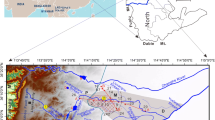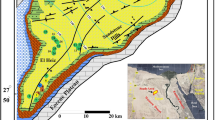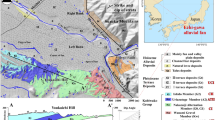Abstract
Groundwater plays a vital role in the arid Southern Gobi Region (SGR) of Mongolia. It is the only source of water supply and is largely utilized for mining operations, such as those at Oyu Tolgoi Mine. The area is expected to face severe water shortages for mining and drinking water, which may be related to changes in groundwater recharge due to climate change. Understanding the geochemical evolution of groundwater and recharge mechanisms is thus paramount for water resource management. In this study, for the first time, chemical and isotopic approaches have been used to characterize the groundwater origin and its associated recharge processes in the Gunii Khooloi basin, which is located in the SGR. Shallow groundwater is mainly characterized by Na(HCO3) and NaCl type; however, Gunii Khooloi aquifer is classified as NaCl type with high electrical conductivity. The stable isotope composition of the water in the deep Cretaceous confined aquifer shows depletion in 2H and 18O relative to modern rainfall and the Quaternary shallow aquifer, which indicates a weak interaction between the two aquifers. Modern groundwater was identified in the shallow streambed aquifer, probably due to the direct infiltration of rainfall. On the other hand, 14C ages in the deep groundwater range from 2,800 to 33,500 years, which suggests that this is paleowater that was recharged during the glacial age. The results indicate that there is a need for strategic groundwater management in the Gunii Khooloi basin.
Résumé
L’eau souterraine joue un rôle vital dans la région aride du Sud du Gobi (RSG) en Mongolie. Elle constitue la seule source d’approvisionnement en eau et est largement utilisée pour les activités minières, telles que celles autour de la mine d’Oyu Tolgoi. Il est anticipé que ce secteur soit impacté par de sérieuses pénuries d’eau pour la mine et pour l’alimentation potable, qui pourraient être liées à des modifications de la recharge des nappes causées par le changement climatique. La compréhension de l’évolution chimique des eaux souterraines et des mécanismes de recharge est donc essentielle pour la gestion de ces ressources en eau. Dans le cadre cette étude, pour la première fois, des approches chimique et isotopique ont été mises en œuvre pour caractériser l’origine des eaux souterraines et les processus de recharge associés dans le bassin de Gunii Khooloi, situé dans la RSG. La nappe superficielle est caractérisée essentiellement par des eaux de type Na(HCO3) et NaCl ; cependant, les eaux de l’aquifère de Gunii Khooloi sont de type NaCl avec des conductivités électriques élevées. La signature des isotopes stables des eaux de l’aquifère crétacé captif profond présente des valeurs appauvries en 2H and 18O par rapport aux pluies actuelles et à l’aquifère superficiel quaternaire, indiquant la faible interaction entre les deux aquifères. Des eaux souterraines récentes ont été identifiées dans l’aquifère alluvial superficiel, probablement en lien avec une infiltration directe de la pluie. D’autre part, les âges 14C des eaux souterraines profondes sont compris entre 2,800 et 33,500 ans, ce qui suggère qu’il s’agit d’eau ancienne rechargée lors de la période glaciaire. Ces résultats indiquent la nécessité d’une gestion stratégique des eaux souterraines dans le bassin de Gunii Khooloi.
Resumen
El agua subterránea desempeña un papel vital en la región árida del Gobi Meridional (SGR) en Mongolia. Es la única fuente de suministro de agua y se utiliza en gran medida para operaciones mineras, como las de la mina Oyu Tolgoi. Se prevé que la zona se enfrentará a una grave escasez de agua para la minería y el agua potable, que puede estar relacionada con los cambios en la recarga del agua subterránea debido al cambio climático. Comprender la evolución geoquímica del agua subterránea y los mecanismos de recarga es, por lo tanto, fundamental para la gestión de los recursos hídricos. En este estudio, por primera vez, se han utilizado enfoques químicos e isotópicos para caracterizar el origen del agua subterránea y sus procesos de recarga asociados en la cuenca de Gunii Khooloi, que se encuentra en la SGR. Las aguas subterráneas poco profundas se caracterizan principalmente por ser de tipo Na(HCO3) y NaCl; sin embargo, el acuífero Gunii Khooloi está clasificado como tipo NaCl con alta conductividad eléctrica. La composición isotópica estable del agua en el acuífero confinado profundo del Cretácico muestra un empobrecimiento en 2H and 18O en relación con las precipitaciones modernas y el acuífero poco profundo del Cuaternario, lo que indica una débil interacción entre los dos acuíferos. Se identificó agua subterránea moderna en el acuífero del lecho del arroyo, probablemente debido a la infiltración directa de las lluvias. Por otro lado, las edades de 14C en las aguas subterráneas profundas oscilan entre 2,800 y 33,500 años, lo que sugiere que se trata de una paleoagua que fue recargada durante la era glacial. Los resultados indican que es necesaria una gestión estratégica de las aguas subterráneas en la cuenca del Gunii Khooloi.
摘要
地下水在蒙古南部戈壁地区(SGR)起着重要作用。它是唯一的供水来源, 主要用于采矿, 例如Oyu Tolgoi矿。由于气候变化引起的地下水补给条件变化,该地区将面临严重的采矿和饮用水方面的缺水问题。因此了解地下水的地球化学演化和补给机制对于水资源管理至关重要。该研究首次应用化学和同位素方法来描述位于SGR的Gunii Khooloi盆地的地下水来源及其相关的补给过程。浅层地下水主要以Na(HCO3)和NaCl型为主;然而Gunii Khooloi含水层地下水被归类为具有高导电性的NaCl类型水。相对于现代降雨和第四纪浅层含水层,深层白垩纪承压含水层中水的稳定同位素组成中2H和18O衰减,反映两个含水层间的水力联系较弱。可能由于降雨的直接入渗影响, 浅层河床含水层中发现了现代地下水。同时深层地下水中14C年龄在2,800至33,500年, 说明这是在冰川时期补给的古水。整个研究表明Gunii Khooloi盆地需要进行战略性地下水管理。
Resumo
As águas subterrâneas desempenham um papel vital na região árida do sudeste de Gobi (RSG) da Mongólia. Essa é a única fonte de fornecimento de água e é amplamente utilizado para as operações em minas, como aquelas na mina Oyu Tolgoi. É esperado que a área enfrente uma escassez severa de água para mineração e abastecimento, que pode estar relacionado com as mudanças na recarga das águas subterrâneas devido às mudanças climáticas. Entender a evolução geoquímica das águas subterrâneas e os mecanismos de recarga são, assim, parâmetro para o gerenciamento dos recursos hídricos. Nesse estudo, pela primeira vez, as abordagens químicas e isotópicas foram utilizadas para caracterizar a origem das águas subterrâneas e seus processos de recarga associados na Bacia de Gunii Khooloi, que está localizada na RSG. Águas subterrâneas rasas são caracterizadas principalmente por tipos Na(HCO3) e NaCl ; entretanto, o aquífero Gunii Khooloi é classificado como tipo NaCl com alta condutividade elétrica. A composição dos isótopos estáveis da água no aquífero profundo confinado do Cretáceo mostra depleção em 2H e 18O relativo à precipitação moderna e aos aquíferos rasos do Quaternário, que indicam uma interação fraca entre os dois aquíferos. Águas subterrâneas modernas foram identificadas em aquífero com pouca profundidade, provavelmente pela infiltração direta da precipitação. Por outro lado, as idades de 14C em águas subterrâneas profundas variam de 2,800 à 33,500 anos, o que sugere que se trata de água paleolítica que foi recarregada durante a era glacial. Os resultados indicam que existe a necessidade de gerenciamento estratégico das águas subterrâneas na Bacia de Gunii Khooloi.









Similar content being viewed by others
References
Badarch G, Cunninghamb WD, Windley BF (2002) A new terrane subdivision for Mongolia: implications for the Phanerozoic crustal growth of Central Asia. J Asian Earth Sci 21:87–110
Bahir M, Ait Tahar M, Goumih A, Ouhamdouch S, Rouissa A (2018) Impact of mine polymetallic Draa Sfar South on the aquifer of central Haouz (Morocco). J Mater Environ Sci 9:1405–1410
Benjamin L, Knobel LL, Hall LF, Cecil LD, Green JR (2004) Development of a local meteoric water line for southeastern Idaho, western Wyoming, and south-central Montana. US Geol Surv Sci Invest Rep 2004–5126
Burenkhuu E, Gotovsuren A, Badarch G, Davgatseren A (1995) Complex geological map of Galbiin Govi Area, 1:200 000 (in Mongolian). Open File Report 4877, Geological Fund of Mongolia, Ulaanbaatar, Mongolia
Chen F, Wu D, Chen J, Zhou A, Yu J, Shen J, Wang S, Huang X (2016) Holocene moisture and East Asian summer monsoon evolution in the northeastern Tibetan Plateau recorded by Lake Qinghai and its environs: a review of conflicting proxies. Quat Sci Rev 154:111–129
Clark I, Fritz P (1997) Environmental isotopes in hydrogeology. Lewis, Boca Raton, FL
Coplen TB, Herczeg AL, Barnes C (2000) Isotope engineering-using stable isotopes of the water molecule to solve practical problems. In: Cook PG, Herzeg A (eds) Environmental tracers in subsurface hydrology. Kluwer, Boston, pp 79–110
Craig H (1957) Isotopic standards for carbon and oxygen and correction factors for mass-spectrometric analysis of carbon dioxide. Geochim Cosmochim Acta 12:133–149
Craig H (1961) Isotopic variations in meteoric waters. Science 133:1702–1703
Dansgaard W (1964) Stable isotopes in precipitation. Tellus 16:436–468
Edmunds WM (2001) Palaeowaters in European coastal aquifers: the goals and main conclusions of the PALAEAUX project. In: Edmunds WM, Milne CJ (eds) Paleowaters in coastal Europe: evolution of groundwater since the late Pleistocene. Geol Soc London Spec Publ 189:1–16
Edmunds WM, Ma JZ, Aeschbach-Hertig W, Kifter R, Darbyshire DPF (2006) Groundwater recharge history and hydrogeochemical evolution in the Minqin Basin, North West China. Appl Geochemistry 21:2148–2170
Felauer T, Schlütz F, Murad W, Mischke S, Lehmkuhl F (2012) Late Quaternary climate and landscape evolution in arid Central Asia: a multiproxy study of lake archive Bayan Tohomin Nuur, Gobi Desert, southern Mongolia. J Asian Earth Sci 48:125–135
Fontes J-C, Garnier J-M (1979) Determination of the initial 14C activity of the total dissolved carbon: a review of the existing models and a new approach. Water Resour Res 15:399–413
Fontes J (1983) Dating of groundwater. In: Guidebook on nuclear techniques in hydrology. Technical Report Series no. 91. IAEA, Vienna, pp 285–317
Gat J (1980) The isotopes of hydrogen and oxygen in precipitation. In: Fritz P, Fontes JC (eds) Handbook of environmental isotope geochemistry, vol 1. The terrestrial environment. Elsevier, Amsterdam, pp 21–47
Gates JB, Edmunds WM, Darling WG, Ma JZ, Pang ZH, Young AA (2008) Conceptual model of recharge to southeastern Badain Jaran Desert groundwater and lakes from environmental tracers. Appl Geochem 23:3519–3534
Glynn PD, Plummer LN (2005) Geochemistry and the understanding of ground-water systems. Hydrogeol J 13:263–287
Guendouz A, Moulla AS, Edmunds WM, Zouari K, Shand P, Mamou A (2003) Hydrogeochemical and isotopic evolution of water in the Complexe Terminal aquifer in the Algerian Sahara. Hydrogeol J 11:483–495
IAEA/WHO (2018) Global Network of Isotopes in Precipitation: the GNIP Database. https://nucleus.iaea.org/wiser. Accessed 24 January 2018
Ingerson E, Pearson F (1964) Estimation of age and rate of motion of groundwater by the 14C-method. In: Recent researches in the fields of atmosphere, hydrosphere, and nuclear geochemistry. Sugawara Festival Volume. Maruzen, Tokyo, pp 263–283
Jahn B, Wu F, Chen B (2000) Granitoids of the Central Asian Orogenic Belt and continental growth in the Phanerozoic. Trans R Soc Edinb Earth Sci 91:181–193
Kamel S, Younes H, Chkir N, Zouari K (2008) The hydrogeochemical characterization of ground waters in Tunisian Chott’s region. Environ Geol 54:843–854
Koldisheva RY, Efimova DV, Grishina AP (1986) Hydrogeological map of the south eastern Mongolia, K-48-B, 1:500 000 (in Russian). Open File Report 3959, Geological Fund of Mongolia, Ulaanbaatar
Kovalenko VI, Yarmoluyk VV, Sal’nikova EB, Kozlovsky AM, Kotov AB, Kovach VP, Savatenkov VM, Vladykin NV, Ponomarchuk VA (2006) Geology, geochronology, and geodynamics of the Khan Bogd Alkali Granite Pluton in southern Mongolia. Geotectonics 40:450–466
Lehmkuhl F, Grunert J, Hülle D, Batkhishig O, Stauch G (2018) Paleolakes in the Gobi region of southern Mongolia. Quat Sci Rev 179:1–23
Li X, Zhang L, Hou X (2008) Use of hydrogeochemistry and environmental isotopes for evaluation of groundwater in Qingshuihe Basin, northwestern China. Hydrogeol J 16:335–348
Liu J, Chen Z, Wei W, Zhang Y, Li Z, Liu F, Guo H (2014) Using chlorofluorocarbons (CFCs) and tritium (3H) to estimate groundwater age and flow velocity in Hohhot Basin, China. Hydrol Process 28:1372–1382
Ma JZ, Wang XS, Edmunds WM (2005) The characteristics of groundwater resources and their changes under the impacts of human activity in the arid Northwest China: a case study of the Shiyang River Basin. J Arid Environ 61:277–295
Ma JZ, Ding Z, Gates JB, Su Y (2008) Chloride and the environmental isotopes as the indicators of the groundwater recharge in the Gobi Desert, northwest China. Environ Geol 55:1407–1419
Ma JZ, Ding Z, Edmunds WM, Gates JB, Huang T (2009) Limits to recharge of groundwater from Tibetan plateau to the Gobi Desert: implications for water management in the mountain front. J Hydrol 364:128–141
Ma JZ, Pan F, Chen L, Edmunds WM, Ding Z, He J, Zhou K, Huang T (2010) Isotopic and geochemical evidence of recharge sources and water quality in the Quaternary aquifer beneath Jinchang city, NW China. Appl Geochem 25:996–1007
Ma JZ, He JH, Qi S, Zhu GF, Zhao W, Edmunds WM, Zhao YP (2013) Groundwater recharge and evolution in the Dunhuang Basin, northwestern China. Appl Geochem 28:19–31
Mahlknecht J, Schneider JF, Merkel BJ, Navarro de Leon I, Bernasconi SM (2004) Groundwater recharge in a sedimentary basin in semi-arid Mexico. Hydrogeol J 12:511–530
Mook W (1976) The dissolution-exchange model for dating groundwater with 14C. In: Interpretation of environmental isotope and hydrochemical data in groundwater hydrology. International Atomic Energy Agency (IAEA), Vienna, pp 213–225
Munkhbaatar N, Sanjdorj S, Ulziibayar G, Chuluunbaatar S (2004) Groundwater exploration report for Oyu Tolgoi process water supply in the Gunii Khooloi and Galbiin Gobi region (in Mongolian). Open File Report, Ministry of Nature and Environment, Ulaanbaatar, Mongolia, pp 23–31
O’Shea B, Jankowski J (2006) Detecting subtle hydrochemical anomalies with multivariate statistics: an example from “homogeneous” groundwaters in the Great Artesian Basin, Australia. Hydrol Process 20:4317–4333
Ortega-Guerrero A, Cherry JA, Aravena R (1997) Origin of pore water and salinity in the lacustrine aquitard overlying the regional aquifer of Mexico City. J Hydrol 197:47–69
Ouhamdouch S, Bahir M, Souhel A, Paula C (2016) Vulnerability and impact of climate change processes on water resource in semi-arid areas: in Essaouira basin (Morocco). In: Grammelis P (ed) Energy, transportation and global warming, green energy and technology. Springer, Cham, Switzerland, pp 719–736
Ouhamdouch S, Bahir M, Carreira PM (2018) Impact du changement climatique sur la ressource en eau en milieu semi-aride: exemple du bassin d’Essaouira (Maroc) [Impact of climate change on semi-arid water resources: example of the Essaouira Basin (Morocco)]. Rev Sci l’eau 31:13–27
Pang Z, Kong Y, Froehlich K, Huang T, Yuan L, Li Z, Wang F (2011) Processes affecting isotopes in precipitation of an arid region. Tellus, Ser B Chem Phys Meteorol 63:352–359
Piper AM (1944) A graphic procedure in the geochemical inter-relation of water analyses. Trans Am Geophys Union 25:914–928
Plummer LN, Prestemon EC, Parkhurst DL (1994) An interactive code (NETPATH) for modeling NET geochemical reactions along a flow PATH, version 2.0. US Geol Surv Water Resour Invest Rep 94-4169, 130 pp. https://doi.org/10.3133/wri944169
Ragab R, Prudhomme C (2002) Climate change and water resources management in arid and semi-arid regions: prospective and challenges for the 21st century. Biosyst Eng 81:3–34
Şengör AM, Natal’in BA, Burtman VS (1993) Evolution of the Altaid tectonic collage and Paleozoic crustal growth in Eurasia. Nature 364:299–307
Stauch G (2016) Multi-decadal periods of enhanced aeolian activity on the north-eastern Tibet Plateau during the last 2 ka. Quat Sci Rev 149:91–101
Stiff HAJ (1951) The interpretation of chemical water analysis by means of patterns. J Pet Technol 3:15–17
Su YH, Zhu GF, Feng Q, Li ZZ, Zhang FP (2009) Environmental isotopic and hydrochemical study of groundwater in the Ejina Basin, northwest China. Environ Geol 58:601–614
Sundaram B, Feitz AJ, de Caritat P, Plazinska A, Brodie RS, Coram J, Ransley T (2009) Groundweater sampling and analysis: a field guide. Geoscience Australia Record 2009(27):95
Tamers M (1967) Surface-water infiltration and groundwater movement in arid zones of Venezuela. Isotopes in Hydrology, Proceedings Series, International Atomic Energy Agency (IAEA), Vienna, pp 339–351
Tizro TA, Voudouris KS (2008) Groundwater quality in the semi-arid region of the Chahardouly basin, West Iran. Hydrol Process 22:3066–3078
Tuvdendorj A, Sanjdorj S, Ulziibayar G (2008) Report on groundwater exploration in the Gunii Khooloi Deposit (in Mongolian). Open File Report, Ministry of Nature and Environment, Ulaanbaatar, Mongolia, pp 22–30
Vogel J (1970) Carbon-14 dating of groundwater. In: Proceedings of a symposium on isotope hydrology. International Atomic Energy Agency (IAEA), Vienna, pp 225–239
Wang P, Yu J, Zhang Y, Liu C (2013) Groundwater recharge and hydrogeochemical evolution in the Ejina Basin, northwest China. J Hydrol 476:72–86
Wang L, Dong Y, Xu Z (2017) A synthesis of hydrochemistry with an integrated conceptual model for groundwater in the Hexi Corridor, northwestern China. J Asian Earth Sci 146:20–29
Windley BF, Alexeiev D, Xiao W, Kroner A, Badarch G (2007) Tectonic models for accretion of the Central Asian Orogenic Belt. J Geol Soc London 164:31–47
Winograd IJ, Robertson FN (1982) Deep oxygenated ground water: anomaly or common occurrence? Science 216(80):1227–1230
Yang Q, Xiao H, Zhao L, Yang Y, Li C, Zhao L, Yin L (2011) Hydrological and isotopic characterization of river water, groundwater, and groundwater recharge in the Heihe River basin, northwestern China. Hydrol Process 25:1271–1283
Yang X, Scuderi LA (2010) Hydrological and climatic changes in deserts of China since the late Pleistocene. Quat Res 73:1–9
Zhu GF, Li ZZ, Su YH, Ma JZ, Zhang YY (2007) Hydrogeochemical and isotope evidence of groundwater evolution and recharge in Minqin Basin, Northwest China. J Hydrol 333:239–251
Zhu GF, Su YH, Feng Q (2008) The hydrochemical characteristics and evolution of groundwater and surface water in the Heihe River Basin, northwest China. Hydrogeol J 16:167–182
Acknowledgments
The authors thank Oyu Tolgoi Mine’s hydrogeologist P. Uuganbayar for help and advice during this study, and we thank his team in the Oyu Tolgoi mine for giving us the opportunity to collect water samples from deep production wells of the Gunii Khooloi aquifer. We thank editor Martin Appold, associate editor Randy Scotler, technical editorial advisor Sue Duncan and two anonymous reviewers for their constructive suggestions, comments and kind corrections.
Funding
The Authors are grateful to the Japan International Cooperation Agency (JICA) for granting the first author a study fellowship (“KIZUNA” project) to carry out his doctorate research work at Tohoku University, Japan.
Author information
Authors and Affiliations
Corresponding author
Rights and permissions
About this article
Cite this article
Bayanzul, B., Nakamura, K., Machida, I. et al. Construction of a conceptual model for confined groundwater flow in the Gunii Khooloi Basin, Southern Gobi Region, Mongolia. Hydrogeol J 27, 1581–1596 (2019). https://doi.org/10.1007/s10040-019-01955-8
Received:
Accepted:
Published:
Issue Date:
DOI: https://doi.org/10.1007/s10040-019-01955-8




